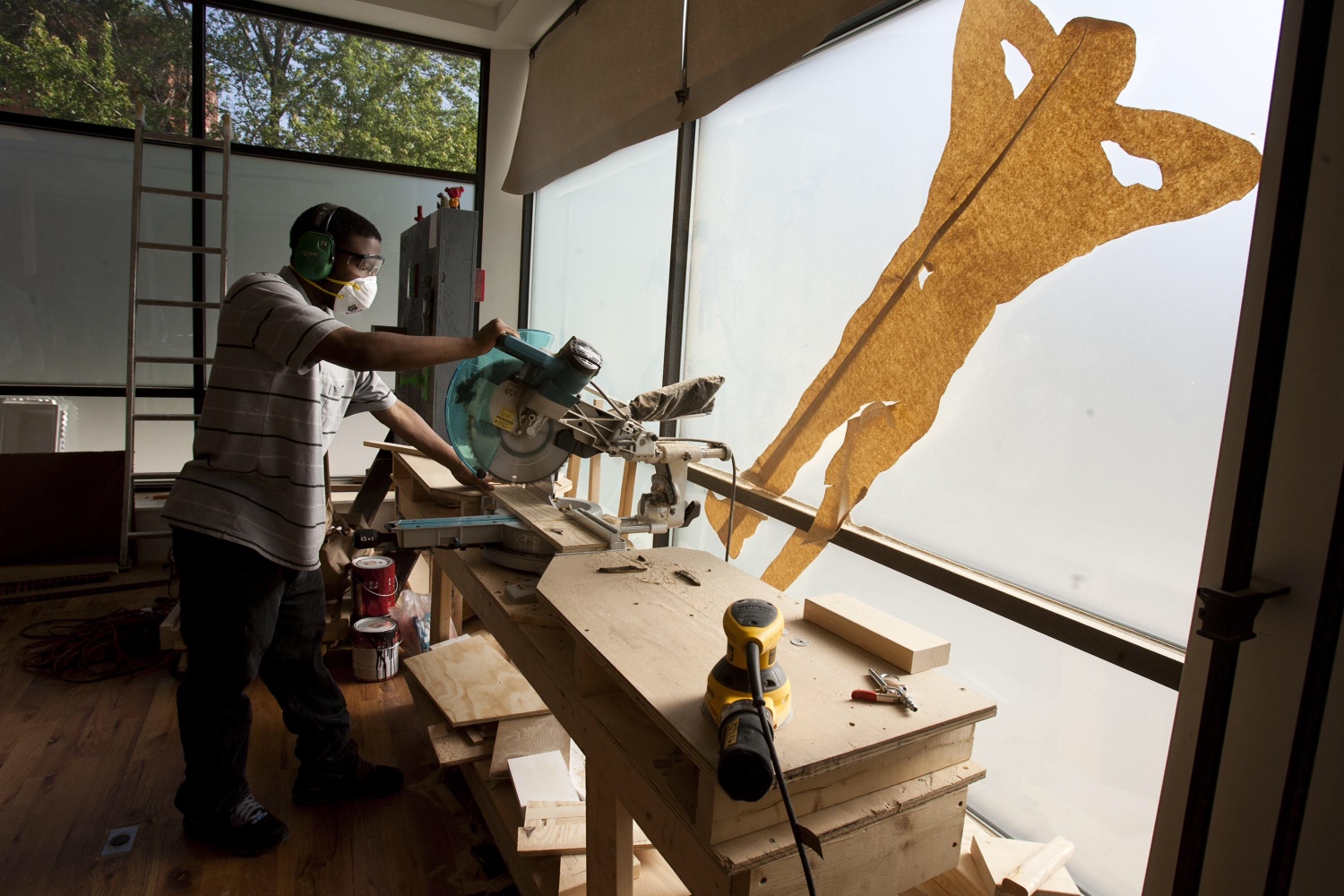
Place Project spreads artistic model of resident engagement to new communities
Theaster Gates, an urban planner and sculptor, is director of the Arts and Public Life initiative at the University of Chicago. Below, he writes about the Place Project a national model for revitalizing communities through arts and culture supported by Knight Foundation. Above: Artist-in-residence avery r. young, Tina Howell and Yaw sing with the group Low Tide during the evening reception at the Arts Incubator Friday, March 8, 2013, in Chicago’s Washington Park neighborhood. Photo by Robert Kozloff.
I grew up on the West Side of Chicago. For years, I watched building after building get torn down around me. At the time, it always seemed like there was a good reason. If something bad was happening in a place—whether it was drugs or prostitution or violence or just the potential for violence—the easiest thing to do was to tear down the building.
People are always looking for the quick fix for urban problems—problems that have been, in some cases, six or seven decades in the making. But tearing down buildings isn’t a solution to the bigger issues troubled neighborhoods face.

Related Link
“University of Chicago taps creative energy of artists for creative projects” by Derek Douglas on KnightBlog.org
As an undergraduate, I became very invested in the idea that people from neighborhoods like the one where I grew up on the West Side should have some responsibility for those places—because maybe nobody else would.
In that sense, the start of my work in creative place-making had everything to do with nostalgia and a sense of duty toward the neighborhood where I grew up. In some ways, I think it started with an urgency to imagine that beautiful things might happen in that neighborhood.
Tearing buildings down is quick. Changing neighborhoods by activating abandoned buildings through art—the kind of community engagement I do—takes time. Still, the beauty of this kind of community engagement is that, once it starts, and once the right structures are in place, it just happens.
The work we are doing at the University of Chicago through the Arts and Public Life initiative is an attempt to build structures that make my kind of community engagement possible, begin making small cultural leaps, and make room for other folk to be engaged.
The opening of the Arts Incubator in Washington Park was the first big step for Arts and Public Life. The building had been fallow for decades when the University bought it. We realized pretty quickly that the arts and culture were a way we could breathe life into the building, make ourselves present in the neighborhood of Washington Park, and find new ways of being generous in that community—and provide a space for students and faculty to interact with working artists.
The Arts Incubator has only been open a year, and it’s already doing a lot. It has an exhibition space up front, three spaces for artists-in-residence, and a flex space for live music performances and so on up top. We offer youth arts programming. We’ve got yoga in the mornings and jazz on Mondays.
We’re trying to do all that while making the Arts Incubator a place whose codes and values and responses resonate with the people around us, the folk who live in and live for their small community, Washington Park.
So how do you do that? How do you help the arts and artists to grow in ambitious ways and make a big impact in the world, while at the same time bringing with you your brothers and sisters next door?
You do it over time. You do it by expressing your values and learning to listen and growing others as the institution grows its own mission. You recognize that place-making isn’t something that happens exclusively through redistricting or the creation of a cultural district; it happens in the hearts and minds of the people who make a place a place. You accept that you are engaged in a durational practice.
Measuring the success of work like this isn’t simple. People want numbers, charts, results, impact analyses. To be quite frank, these things are tertiary to the work I have been involved in until now. Measuring impact is not what artists do.
For me, that’s a big part of what the Place Project is all about. I think it’s time to look at this work in more complicated ways—with the help of folk who are trained to hang back, observe, ask hard questions and offer critical feedback that can inform its future. With their help, we can bring this model of community engagement through culture to other cities, other communities, other neighborhoods like the one I grew up in. I am coming to understand this new phase of the work as a series of slow measurements.
With support from Knight Foundation, I will be able to have the team that slowly measures with me. Through the Place Project, we will have several years to be a part of a listening process and a series of provocations that I hope will challenge all of our normal ways of believing in a place.
We believe that there is room—not only in Washington Park, but in disinvested neighborhoods everywhere—for new businesses and the ones currently there, for new residents and lifers, for new ways of thinking and wisdom that has been in the neighborhood for a long time. We will be present and measure together.
Recent Content
-
Community Impactarticle ·
-
Community Impactarticle ·
-
Community Impactarticle ·


